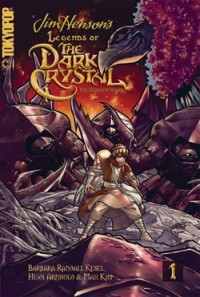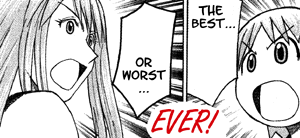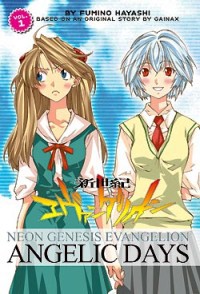RIGHT TURN ONLY!!
All the Lovely Parasytes
by Carlo Santos,

You've gotta love Shojo Beat magazine's amusement value. The December '07 issue has a Baby, the Stars Shine Bright ad on the back, and what does it say in the top right corner? "Western size clothes coming soon!!" Yes. We're fat. And large. Thanks for the reminder.
LOVE*COM

Vol. 3
(by Aya Nakahara, Viz Media, $8.99)
FROM THE BACK COVER:
"Risa Koizumi is the tallest girl in class, and the last thing she wants is the humiliation of standing next to Atsushi Ôtani, the shortest guy. But fate and the whole school have other ideas, and the two find themselves cast as the unwilling stars of a bizarre romantic comedy.
A new student starts out as Risa's rival for love, but ends up proving how important it is to be honest with yourself!"
EVIDENCE FOR:
The title says it all: this series is Lovely, and the relationships are wonderfully Complex. Not in the everybody-loves-everybody-else way, but in the way emotions layer over each other to create fascinating characters. Case in point: Risa, whose brash exterior serves as a cover-up for her insecurity issues, which in turn comes from her unexpected affection towards Ôtani. Even the side characters have their complexities—would-be suitor Haruka has a surprising reason for liking Risa, and super-cute newcomer Seiko has a secret that yields hilarious results. (Heck, even when the secret isn't out yet, she's still hilarious.) With a strong ensemble cast now in place, all that's left is to top it off with entertainment value, and that's where Ôtani comes in, pairing up with Risa for some of the snappiest, funniest dialogue ever translated. Okay, so the Osaka dialect doesn't come out in English—but you don't need Japanese fluency to laugh at Ôtani's boast about "the era of the little man," or any of the other height jokes traded so effortlessly between our hero and heroine. A clean, easygoing art style adds an attractive touch, with cute expressions and contemporary fashions that giving everyone a likeable, down-to-earth feel. It's like catching up with a group of really cool, really funny friends, and you just can't wait to hang out with them again.
EVIDENCE AGAINST:
The course of true love never did run smooth; rather, it goes in annoying circles that repeat the same thing over and over. That might be your general feeling too after seeing Risa announce "There's no way I could be in love with him, because I'm too tall" for about the seventh time. And that's not the only example of filler dialogue—each chapter could easily be cut down by about 5-10 pages just by getting rid of all the pointless love chatter. Blame it on observers like Nobu, who exists only to discuss whether Risa should go out with Ôtani, and how to fend off various rivals. It's the catty, gossipy side of Love*Com that we could do without, because it's kind of annoying in real life, and it isn't any better on paper. Other annoyances include the tendency to fall back on high-school romance clichès: the resolution to the Haruka storyline completely fizzles out, and Seiko's secret will come as no surprise to veteran manga readers. For a series with such a delightfully fresh attitude, it sure digs up some stale plot elements.
FINAL VERDICT:
Forget the complaints. With Risa's feelings kicking into high gear and a constant stream of one-liners, this might be the best romantic comedy running right now—give it an A-.
PARASYTE

Vol. 2
(by Hitoshi Iwaaki, Del Rey, $12.95)
FROM THE BACK COVER:
"Shin looks like an ordinary high school boy, but he has a terrible secret: an alien parasite has infected his body. This mysterious creature is ruthless, deadly, and utterly indifferent to human suffering ... and it is beginning to assert itself over Shin. As Shin fights for control of his body, can he also hold on to his humanity?"
EVIDENCE FOR:
How do you make the hero in a sci-fi thriller really start panicking? Go after his mom, of course. Shinichi's silent war against the parasite invasion gets much more serious in this volume, as his mother turns out to be the latest victim of infection. It's suspense and action distilled to its purest form, with splashes of horror imagery as well: a human head splitting apart, a guy getting stabbed through the heart, and the freakish contortions of the parasites in general. However, it's the quiet, methodical pacing that really makes the story addictive—there's plenty of walking-and-talking time in this volume, yet the knowledge that the parasites are out there, waiting to get Shinichi, makes it all the more suspenseful. Contrast this to the visceral high-speed fight scenes, and it's easy to see why this rhythm of fast and slow makes for such great storytelling. The introduction of a side character who's quite different from anyone else also adds a new wrinkle to the story, and once you see the "new" Shinichi who arrives back at school after his summer sojourn, well ... let's just say that things are getting a whole lot more interesting. Volume 3 can't come soon enough.
EVIDENCE AGAINST:
Wait a minute, what happened to all the big philosophical things from the first volume? This time we've got Shin briefly trying to prove that he's human, and wondering if Migi is on his side or not, but otherwise this volume ditches the heady ideas in exchange for more conventional action. There isn't even much about understanding the science behind the parasites, apart from Shin's physiological changes in mid-volume. Basically, this installment has switched away from the intellectual side and opted for more blood and guts, making it look a lot more like, well, the average stuff out there. Other shortcomings are more minor, but they do add up: the lackluster participation of the girls in Shinichi's life (it's like they show up for a while, say hi and leave), the occasionally stiff poses that take the fight scenes down a notch, and the frequent lack of backgrounds in the art. There's clearly a very talented artist at work here—so why not use that talent?
FINAL VERDICT:
It's the great main character and the suspense that really drive this series, and as long as that holds strong, it's still worthy of an A-.
PUMPKIN SCISSORS

Vol. 1
(by Ryotaro Iwanaga, Del Rey, $10.95)
FROM THE BACK COVER:
"The bitter war between the Empire and the Republic of Frost has ended, but three years after the cease-fire, the Empire is still ravaged by starvation and disease, and bandits terrorize the populace. Can the Imperial Army State Section III, aka Pumpkin Scissors, stop a renegade force bent on wanton destruction? And who is the mysterious stranger helping Pumpkin Scissors?"
EVIDENCE FOR:
It may look like a typical military action series, but don't be fooled: Pumpkin Scissors is about more than just beating the bad guys. The unit's main goal is, as is so often repeated, "war relief and reconstruction," which leads to a number of interesting scenarios. In one story, the troops are sent out to deal with a nobleman oppressing the local townsfolk, and in the last chapter, high-strung idealist Alice ponders the income gap between herself and the impoverished war victims. Who says manga isn't educational? I've got your social studies discussion material right here. But don't worry, this one also covers the "action" part of military action, with most of the gunplay coming from super-soldier Randel (the aforementioned mysterious stranger). Not only is he a well-designed character—the impressive height and facial scar are hard to miss—but his gentle demeanor provides an interesting counterpoint to his brutal tactics on the battlefield. Bold, sharp lines help to accentuate the explosive action scenes; the conventional weapons and down-to-earth setting make it feel like a "real" post-war experience even though the world is fictional.
EVIDENCE AGAINST:
Ever feel like you've been thrown into a story with no idea about what's going on? That's what it seems like here, where the big picture leaves many questions unanswered. Why did the Empire and the Republic get into a war in the first place? How did the ceasefire leave the Empire in such disarray? Heck, who's the Emperor? And what did the folks at the Pumpkin Scissors unit do before they got into war relief? Ironically, the only character who gets any substantial back-story is Randel, and he's supposed to be the mysterious one (although learning about his special power is pretty cool). Aside from that, it just seems pointless to bring up social issues when there's no greater context in which to understand it. The plotting is also fairly formulaic, despite the long chapters; everything amounts to helping out the downtrodden and beating up bad guys as needed. You can almost predict how far into each chapter the combat portion is going to start, and that's never a good sign. Let's hope that future storylines develop into something more than just the Mission!! of the Week.
FINAL VERDICT:
If you like tanks and guns and crisp army uniforms, go for it, but with the story being as underdeveloped as it is, this one gets a C+.
SUPPLI

Vol. 1
(by Mari Okazaki, Tokyopop, $9.99)
FROM THE BACK COVER:
"The skies are always clearer after a storm...
After her boyfriend of seven years dumps her, Minami Fujii realizes she's shut out everything else in her life. Now, at twenty-seven years old, ambitious Minami throws herself into her advertising job and experience life—and love—for the first time.
From Mari Okazaki, the edgy, provocative author of Sweat and Honey, comes a tale of rediscovering love."
EVIDENCE FOR:
If there's one area where Suppli blows away all other manga romances, it's in how real it feels. Or maybe that's just because the main characters are actually in my age range for once. Whatever it is, the series' modern workplace setting is a perfect stage for the ups and downs of grown-up love. Clingy colleagues you'd rather stay away from, co-workers plotting behind your back, and of course, that one person in another department who seems really, really attractive—the world of Suppli succeeds not because of far-out fantasy, but because it's so believable and contemporary. Things really kick off once Minami gets out of her dead-end relationship and falls into the hectic pace of the ad industry: over the next several chapters we're treated to the snappy, syncopated rhythms of modern life, as our heroine tries to juggle finicky clients, impossibly tight schedules, and potential romantic interests. Okazaki's elegant artwork brings it all together to provide the complete package: stylish characters who aren't afraid to wear their emotions on their faces, set against dreamy, impressionistic backgrounds. Once you've outgrown all the sappy high school romances, this is the stuff that's truly "next generation."
EVIDENCE AGAINST:
Honestly, there's just not enough polish to call this a masterpiece right out of the gate. Like many other first volumes, it does a decent job of establishing the characters, but sacrifices the plotting in order to do so. It takes about half the book before we even start to see where Minami's romantic life is headed, and even then the storyline seems to take too many asides and tangents rather than getting it together. Let's put it this way: if you like your storytelling straightforward and linear, then don't bother with this one, as it bounces around too much, just like the frenzied life that the main character leads. The haphazard layouts also add to that stressed-out feeling, with overlapping panels placed any which way and dialogue directions that are not always clear. If it's going for that sense of modern-day information overload, then it's working, but it also makes the story harder to follow. Those with an artistic eye might also find the overuse of screentones unappealing, as many of the pages end up with a gray, washed-out look.
FINAL VERDICT:
It's a bit messy still and trying to find its way, but the sharp sophistication of this series earns the opening volume a B+.
UZUMAKI

Vol. 1
(by Junji Ito, Viz Media, $9.99)
FROM THE BACK COVER:
"Kurôzu-cho, a small fogbound town on the coast of Japan, is cursed. According to Shuichi Saito, the withdrawn boyfriend of teenager Kirie Goshima, their town is haunted not by a person or being but by a pattern: uzumaki, the spiral, the hypnotic secret shape of the world. It manifests itself in everything from seashells and whirlpools in water to the spiral marks on people's bodies, the insane obsessions of Shuichi's father and the voice from the cochlea in our inner ear. As the madness spreads, the inhabitants of Kurôzu-cho are pulled ever deeper into a whirlpool of no return!"
EVIDENCE FOR:
Make no mistake: the stories in Uzumaki will seriously freak you out. If the grotesque imagery doesn't do the job, then the messed-up characters will, with behavior so irrational that it's almost too terrifying to be true. Get ready to squirm at the sight of Shuichi's mother mutilating herself, or Kirie's father becoming dangerously obsessed with the idea of spiral pottery. The matter-of-fact storytelling makes it even more shocking; these events are presented in such a natural manner that it contrasts very strongly with the horrors taking place. Ito's greatest accomplishment, though, is making it so that the mere sight of a spiral becomes terrifying—simply because it's a sign that things are not going to end well. What could be more powerful, in the world of comics, than being able to evoke emotion with a single shape or image? Heavy hatching and shading add to the mood, from the smoky spirals in the sky to the facial expressions among the characters. The final touch comes in the form of masterful pacing—if someone's looking scared on the bottom left corner of a page, you can be sure there's something lurking on the other side ... and most terrifying, thrilling part is finding out what it is.
EVIDENCE AGAINST:
It's never a good sign when the manga-ka starts straining for ideas by the end of the first volume. While the first few chapters strike the right tone, things become increasingly far-fetched as Ito tries to come up with more variations on the "creepy town + spirals" formula. A family-feud romance, for example, reaches an ending that isn't just tragic, but tragically cheesy. Silliness also overshadows horror in the final chapter, where the climactic scene involves two girls dueling with their hair. (Didn't we see something like this on Bo-Bobo?) Even the more serious chapters have their own gaps of logic; apparently the irrational behavior of the characters also leads to irrational plot tangents. Anyway, perhaps the idea of focusing on one town and one set of characters wasn't the best move, as this was probably meant to be more like a short story collection based on the theme of spirals. With Ito having forced himself to work in such a restrictive setting, it seems that he's locked into a creative death spiral of his own.
FINAL VERDICT:
The increasingly silly story ideas and lack of a unified plot are a bit irritating, but it's still enough of a good scare to earn a B.

LEGENDS OF THE DARK CRYSTAL

Vol. 1
(by Barbara Randall Kesel, Heidi Arnhold and Max Kim, Tokyopop, $9.99)
FROM THE BACK COVER:
"Lahr and Neffi are gentle and fun-loving Gelflings who want little more than to enjoy the simple pleasures of life and love. But when their villages are attacked and plundered by the violent Garthim, their worlds are turned upside down as they narrowly escape with their lives. Now, united against insurmountable odds, the two Gelflings must put aside their peaceful ways and emerge as heroes to lead a frightened neighboring village into something they never thought they'd face—war."
EVIDENCE FOR:
It may not involve as many hours as reading a high-fantasy prose novel, but this Dark Crystal spinoff captures the epic feel in one compact package. From the archetypal beginnings of a lone shepherd boy minding his herds in the wilderness, it ramps all the way up to a massive battle where the namby-pamby Gelflings take on a full horde of monsters. It's a true underdog story, with our ill-equipped heroes triumphing against impossible odds, and the urgent pacing makes it feel like a big, dramatic affair even if it's packed into a single graphic novel. But while the characters are busy racing against time, don't forget to enjoy the setting as well: this storybook world is as sprawling and imaginative as they come, with all the details worked out from mountain vistas to insect-sized wildlife. If you want to know what fantasy really looks like, this is it, right here—there is nothing in the Dark Crystal world that looks like anything on Earth, not the plants, not the animals, not the monsters, not the sentient creatures. The age of the great Henson fantasy films may be past us, but we're lucky to see that it lives on in new ways.
EVIDENCE AGAINST:
If I could write an open letter of complaint about the "Tokyopop House Style," it would begin something like this: Stop trying to tone every single thing; it's not a coloring book. Stop trying to draw every single thing; it confuses the reader and clutters the page. I could go on, but ... the point of this paragraph is Legends of the Dark Crystal. While the artwork is confident and visually impressive, it does suffer from the aforementioned clutter, driven by the apparent urge to fill in every bit of blank space. Blocky, rectangular paneling and stiff action poses also detract from the energy of the work. The biggest problem, though, lies in the simplified storytelling, where generic fantasy characters act out generic scenes in their generic adventure (the self-sacrificial death, the dramatic "Noooo," the comforting embrace). Let's not kid ourselves here: it's just a paint-by-number quest story that happens to look cool because it borrows some other guy's muppet designs.
FINAL VERDICT:
It's true that there are truckloads of mediocre fantasy works out there, most of which do not deserve to be read, ever. However, the elaborate art and well-paced storyline in this one elevate it above the rest.

Here's a surefire receipe for disaster: take something that was pretty good in the first place, and then "re-imagine" it by removing all the stuff that made it good. End result? One of the Worst Manga I've Ever Read, maybe:
NEON GENESIS EVANGELION: ANGELIC DAYS

(by Fumino Hayashi, original concept by Gainax, ADV Manga, $9.99 each)
Oh, man. I knew I'd have to deal with this one eventually. I really wanted to give Angelic DAYS a chance—everyone loves the high-school parody sequence in the original Eva, right?—but this full-length spinoff series does not deliver. As it turns out, the novelty value of re-imagining Evangelion wears off pretty quickly; it's just not that fun seeing the bleak tone of the original watered down into a third-rate teen sci-fi adventure. Take away Shinji's emotional damage and daddy complex, and he becomes just a generic weak-willed anime guy. Take away the childhood trauma that comes along with Asuka's attitude problem, and she's just a bargain-bin tsundere. Take away Rei's robotic mysteriousness, and she's just another "shy girl" that pops up in every high-school tale ever. Take away Kaworu's Kaworu-ness, and ... well, he does show up a lot more in this series, so we'll call his situation a draw.
But it's not just the characters—the story itself has been conventionalized, so instead of teenagers piloting giant robots and getting caught in a terrible apocalyptic conspiracy, it's now just teenagers piloting giant robots, which is no longer interesting because it was Evangelion that innovated the formula in the first place. The high-school friendship and romance angle is cute, but come on, that's just filler material for überfans who think pairing up characters in a series is more important than the actual story. (Oh well, at least it's not the Harry Potter universe...) Let's face it: this plotline would never have gotten off the ground if it weren't attached to a famous, highly marketable name. Even more inexcusable is the shoddy artwork, which doesn't just violate the original designs, it tramples all over them, throws them down a well, and leaves them for dead. By Volume 3 Shinji has been replaced by Keitaro Urashima minus 10 pounds, or something.
Well, at least those new movies are coming out. And waiting for Yoshiyuki Sadamoto's latest installment of the proper Evangelion manga—even if it does take him another 12 years to finish—is always worth it.
discuss this in the forum (20 posts) |